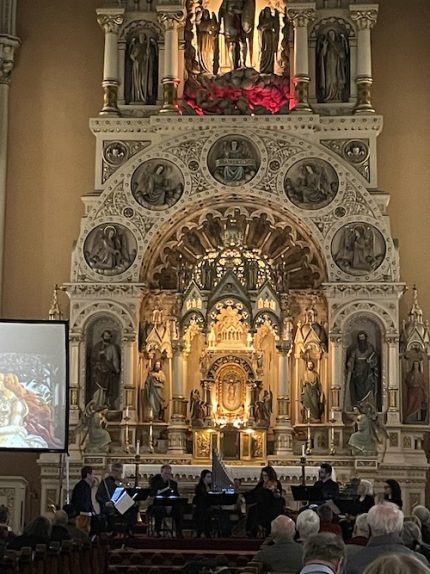Newberry Consort explores the unique music of the Medici court

[Editor’s Note: Technical issues prevented this review from being posted last weekend.]
The Newberry Consort presented a program titled “Music Fit for the Medici” on Friday night, featuring works that wealthy Renaissance arts patron Cosimo de’ Medici collected and preserved of the best Florentine composers of the late 14th century, including Francesco Landini, Jacopo da Bologna, and Lorenzo da Firenze. The program also featured the poetry of Cosimo’s grandson, Lorenzo de’ Medici, who was known equally as a poet and politician.
To bring this concert to life, the Newberry Consort was joined by keyboard virtuosa Catalina Vicens on the organetto—a small portative organ that fits on the lap and is played with one hand while the other hand pumps the bellows. Medieval strings, harp, lute, and percussion filled out the ensemble, along with three singers.
At first, it was an adjustment for the ear to listen to such intimate music within the cavernous but appropriately ornate space of St. Michael’s Catholic Church in Old Town. The space swallowed some of the finer details of the intricate music, but the reverberation proved kind to the singers, particularly as they soared in their upper registers.
The concert featured a mixture of instrumental and vocal pieces taken mainly from two manuscripts from the Medici library: the “Squarcialupi Codex” and the “London British Library Additional Manuscript 29987.” The late medieval vocal writing—characterized by long, interweaving melismatic lines that often have very little to do with each other until the cadences—takes great virtuosity and control, which sopranos Ellen Hargis and Salomé Sandoval and tenor Matthew Dean displayed in spades.
Often singing in pairs or as a trio, their voices blended well, particularly Sandoval and Dean in “Perchè canzato è ’l mondo” by Bartolino da Padova, which featured high-flying runs and unexpected melodic and harmonic turns as it talked about evil intentions lurking behind seemingly friendly faces. Their fluty tones also matched that of the organetto, further emphasizing the instrumental quality of the vocal writing.
Sandoval particularly impressed with her well-controlled floated tone on top of the vocal texture, especially in the tripping lines of Padova’s aptly titled “Non correr troppo e tien la mano al freno” (“Don’t run too fast and hold tight the reins”). However, sometimes she pulled back too much when all three voices were together, sounding a bit tentative. Dean shone in both the tenor and countertenor range, and his blend between the two registers was seamless and assured. Hargis was a stabilizing force as the middle voice in the trio.
The instrumentalists of the Newberry Consort provided sensitive accompaniment during the vocal selections. The pluck of Mark Rimple’s lute and Danny Mallon’s diverse percussive instruments provided indispensable rhythmic grounding and textural interest as the voices swam above, while the earthy-toned vielles of David Douglass and Allison Monroe provided a pleasant contrast to the fluty voices and organetto. Vicens’s expressiveness on the organetto was notable given the limited range of the instrument.
The four instrumental selections provided a nice break, as the more predictable structure and harmonies of the dances were easier for the modern ear to follow than the florid polyphony. However, these selections still took some interesting turns, particularly “Donne, e’ fu credença” by Lorenzo de Firenze, which featured an unusual meandering unison melody and surprising rhythmic hiccups. It would be interesting to see what kind of dance would have been choreographed to such an idiosyncratic piece.
The concert finished with a hedonistic ode to Bacchus, god of agriculture, wine, and fertility, with “Canzona di Bacco” by Lorenzo de’ Medici. The largely syllabic declamation and the predictable solo verse/refrain structure was refreshing after a night of heady polyphony. Plus, it gave the singers the chance to engage with the audience and tell a story, which the challenges of the more intellectual vocal pieces hindered.
Posted in Uncategorized


